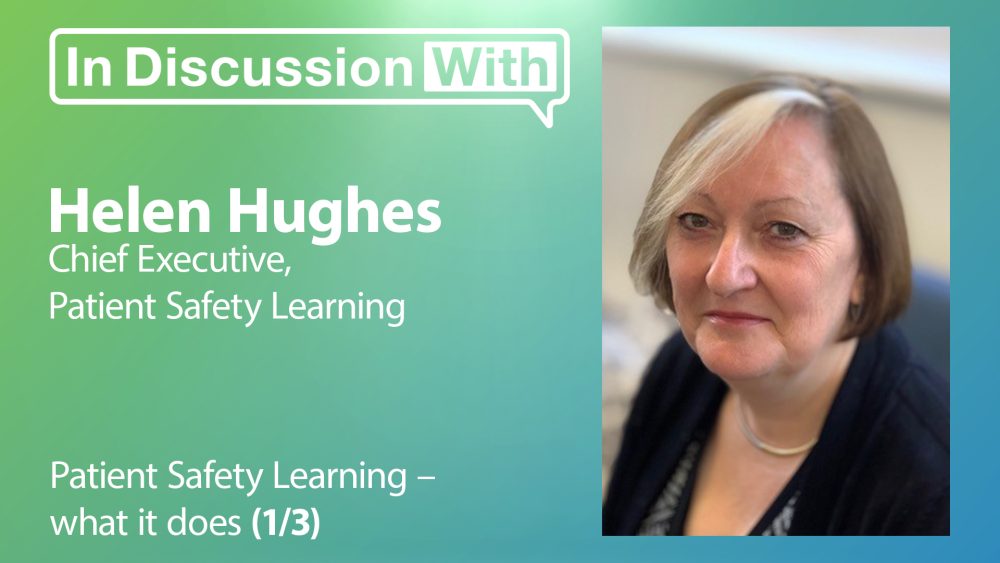Advertisment
Patient Safety Learning – what it does

The Patient Safety Learning Hub is an award-winning platform that serves as an open-access knowledge repository for information about patient safety. We spoke to Chief Executive, Helen Hughes to find out more.
Patient Safety Learning is a charity that works as an independent voice for system-wide change through policy influencing, campaigning and promoting ‘how to’ resources for patient safety Improvement, explains Ms Hughes. The Patient Safety Learning Hub (PSLH) was established to provide free, easily-accessible information about patient safety for everyone. “By everyone we mean literally everyone – so it was designed by and for clinicians, patient safety experts, patients, family members, policy makers, academics – everyone. So, we wanted a knowledge repository, all in one place, that people could find easily and use to inform their campaigning, their work, their education”, she says.
In 2021 the PSLH won the Leading Healthcare Award for the patient safety category and it is now a finalist for another award. Being an award winner gives greater visibility and credibility to the organisation’s work “so it helps with our sharing and our marketing of what we do”, says Ms Hughes.
The PSLH was born of the idea that that “knowledge knows no boundaries – everyone should share for safety”. Even the World Health Organisation (WHO) was thinking about how it could create a global knowledge platform. Ms Hughes explains, “I think it’s not a unique idea – what is unique is the realisation of it. As of last week, we’ve had our millionth page view so in the three years that we’ve developed it …… we’ve got sufficient content on it and engagement with various communities for people to come back and find it valuable. So, what’s unique about us is that we took the ideas and we share the ideas of the Hub and build on that.”
In fact the Hub has now had a million page views from people in more than 200 countries. Although it was started as a UK-based resource, over time more and more people have found out about it and user numbers have grown. There are more than 450,000 unique users that have been using this from around the globe.
Patient safety as a core purpose
One of PSL’s ambitions is to help health care as a system put safety as its core purpose. Ms Hughes says:
“We are very mindful that patient safety and indeed staff safety is often one priority of many and actually we feel it should be a core purpose and it should be designed as such. So, if you look at other industries, they have concepts of ‘Safety Management Systems’ where the whole industry comes together – whether you’re a service provider, whether you’re a regulator, whether you’re a customer and – everyone is very clear what the safety requirements are what the safety standards are and how safety will be delivered. Healthcare as an industry, both in the UK and globally, is just not in that place yet.”
Patient involvement
“Patient involvement in patient safety is absolutely essential and not because it’s the kind and nice thing to do but because it works”, explains Ms Hughes. Research evidence and personal testimonies clearly demonstrate that engaging patients and their families makes care safer.
Patient engagement is needed at three levels. First, at the point of care, when decisions are being made about procedures, about sharing information and about deciding whether to consent for treatment. “The patient safety component of those decisions and that engagement between clinicians and patients and families is essential”, she says. The second level is if things go wrong. “In the UK [there are] 11,000 avoidable deaths each year [due to] unsafe care”, notes Ms Hughes. “If things go wrong it’s important for patients and families to have that knowledge, to have that shared ….. but also, to help understand what went wrong and why. And the patient and family perspective can be quite unique”, she says. The patient and family can see the whole care pathway whereas clinicians tend to see only a component part of it. The third level is in designing new systems and improvements. If things have gone wrong engaging users of the service – patients and families – to help redesign a service enables the organisation to learn from the wisdom of patients and families and make sure that the service meets their needs, she adds.
Helen Hughes has held leadership roles in healthcare in the UK and the WHO, the National Patient Safety Agency, Equality and Human Rights Commission, Parliamentary Health Services Ombudsman and the Charity Commission. Helen’s previous leadership roles in patient safety include, Director of Operations of the National Patient Safety Agency and \executive lead of the global ‘Patients for Patient Safety’ programme at the WHO.
Patient Safety Learning’s the hub is an award-winning platform to share learning for patient safety. It offers a powerful combination of tools, resources, stories, ideas, case studies and good practice to anyone who wants to make care safer for patients. Its communities of interest give people a place to discuss patient safety concerns and how to address them. Membership is free – you can register at www.pslhub.org.
Read and watch the full series on our website or on YouTube.





